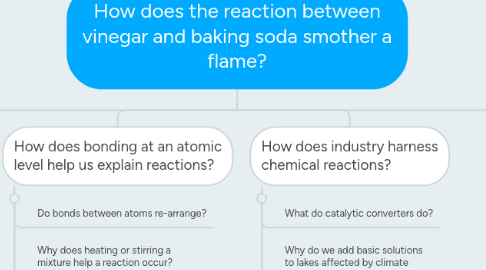How does the reaction between vinegar and baking soda smother a flame?
by Andrea Pugh


1. How does industry harness chemical reactions?
1.1. What do catalytic converters do?
1.2. Why do we add basic solutions to lakes affected by climate change?
1.3. There are 5 different types of reactions
1.3.1. Decomposition reaction: use water to supply hydrogen and oxygen
1.3.2. Scientific literacy: how to translate reactions into equations (and balance them!)
1.3.3. Double replacement: Adding bases to acidic lakes
1.4. Diagnostic tests used in real world for chemicals
1.5. How is fertilizer made?
2. How can we predict states of matter in products of reactions?
2.1. What are the differences between states of matter?
2.1.1. Define in terms of kinetic energy, shape/volume, and the question does it flow?
2.1.1.1. Endo/exothermic reactions
2.1.1.2. Theory of kinetic energy
2.2. Use solubility chart
2.3. Vinegar and baking soda reaction results in CO2 gas
2.4. Theoretical and empirical proof of chemical and physical changes
2.4.1. Lab activities
3. How does bonding at an atomic level help us explain reactions?
3.1. Do bonds between atoms re-arrange?
3.2. Why does heating or stirring a mixture help a reaction occur?
3.3. Physical changes do not re-arrange bonds
3.3.1. Characteristics of chemical changes
3.4. Kinetic molecular theory
3.4.1. Collision- reaction theory
3.4.2. Conservation of mass
3.5. How do the bonds re-arrange in our reaction?
4. How does conservation of mass relate to chemical equations?
4.1. If matter is conserved, why does a log weigh more than the ashes it produces?
4.2. What is the best way to represent ratios?
4.2.1. Links to math
4.2.2. Use simplest whole number ratios
4.2.3. Moles and why they're useful
